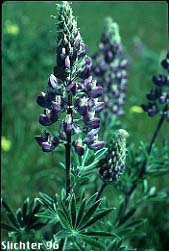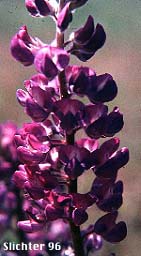#28. Lupine

Common Local Lupines:
Lupinus latifolius Broad-leaf Lupine (grasslands & open woods of west
Columbia Gorge).
Lupinus laxiflorus Spurred Lupine (open woods & grasslands of east
Columbia Gorge).
Lupinus polyphyllus Large-leaf Lupine (Moist ground in open woods
of west & mid Columbia Gorge).
Family Name:
Pea Family
Habitat:
Open forests to meadows.

Characteristics:
1. Grows at all elevations from sea level to alpine areas.
2. Palmately compound leaf with 5 to 15 leaflets radiating from central area.
3. Blue, white, or purple flowers shaped like a crab claw (typical pea flower).
4. Flowers arranged in terminal racemes (at end of flower stem in dense clusters
with flowers arising from all sides of stem).
5. Seeds develop in flattened and often hairy pea pods.
Uses or Importances:
1. Lupine is a Greek word meaning grief. All parts of the plant are poisonous,
so this is one plant not to nibble on!
2. Lupines, like all peas, have symbiotic nitrogen fixing bacteria in their
roots, which help enrich the soil for most plants. Lupines are good nitrogen
fixers.
3. The wild lupines have been domesticated to give us many varieties of lupine
for gardens. There is a greater selection of flower colors available when using
domestic lupines.
Paul Slichter


